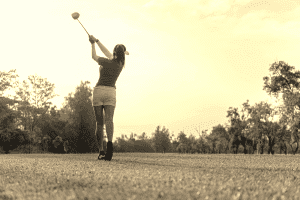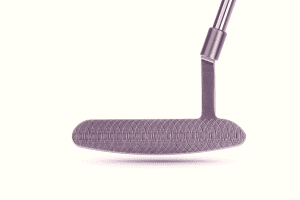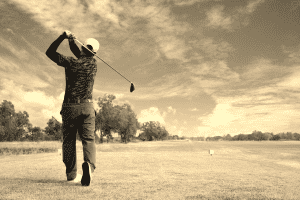Like most things in life, a great golf swing starts with solid foundations. You can have the smoothest and best golf swing in the world, but you will not be consistent if you don’t have the right stance and setup to back it up. We’ve done a deep dive on how to get the proper golf stance for each club, as well as what goes into the perfect golf setup. If you want to nail down this fundamental area of the swing, check out our full guide below.
Proper Golf Stance | Key Principles
The correct golf stance is one of the most fundamental parts of the game. It’s literally the foundation on which you build your swing and is so important to get absolutely nailed down. Creating a solid golf stance relies on getting several elements right. Your alignment, posture, stance width, and ball position all play a part in your stance and set up.
We will address each aspect of the setup separately from alignment to ball position.
Alignment | the key to a proper golf setup
Getting your alignment right is key to creating a consistent swing, and is one of those tricky things that can be a pain to nail down consistently. If your swing feels good but your aim isn’t quite fully in sync, your alignment may be off. Aim and alignment go hand in hand, so it’s important to nail this area of your setup.
Alignment is one of those things that can shift slightly without notice while wreaking havoc on your swing and your pride.
Normal alignment
Imagine standing on a long straight railway track facing sideways in a golf stance. Your feet are on one rail, and the ball is on the other, with the clubface pointing straight down the rail. The rail with the ball on is called the ‘target line’. Essentially where the track is headed is where your ball is going to go. This is a great mental visual on how you should set up to the golf ball. With your body being perfectly parallel to the target line, this is what I will refer to as ‘a normal stance’.
You can see this principle in action right here:
One of the major keys to a great golf swing (and straighter shots) is maintaining a ‘normal stance’. You want a line going over the tips of both of your toes pointing towards your target. The clubface should also be square on to the target, helping you be completely neutral as you hit the ball. The result should in theory be a straight golf shot with minimal shot shape.
Open Stance
Imagine that as you turn your head to look down the track, the tracks are getting further apart. That is the one you are stood on points left, and the one the ball is on moves to the right. As your feet and body start pointing more to the left of your target line, this creates an open stance.
Here’s a great explanation of an open stance to visualize this concept a bit more:
So why would you want an open stance? Players who open their stance slightly are able to produce a fade much more easily, where the ball moves slightly from left to right. An open stance also produces a slightly higher trajectory, and enables a player to put some serious power into their swing thanks to easier hip clearance. Opening your stance can be a powerful tool in your setup, but it depends on the player and what comes more naturally.
Closed Stance
We now want you to imagine that you turn your head and the tracks are gradually getting closer together. The rail you are stood on points slightly right. The one with the ball on is slowly moving left. This is called a closed stance.
Open Stance vs Closed
How you open or close your stance will dictate how the ball flies and where it goes.
An open stance leads to a higher ball flight. It will also impart spin on the ball that will make it move from left to right. This is because relative to the target line, the clubface moves outside and then back in along the line of your feet. An open stance encourages a fade.
A closed stance will lead to a lower flight of the ball. It will also impart spin that will encourage the ball to move from right to left. This is because the club head will move along the line of your feet from an in-out swing path relative to the target line. A closed stance is the best way to get set up to hit a draw.
When you have an open stance, you are essentially creating conditions similar to opening the clubface at impact. As a result, the ball will have a higher trajectory.
When you have a closed golf stance, this has the same effect as closing the clubface, reducing the loft, and making the ball fly lower.
Here’s a great video on how changing your alignment affects your ball flight.
How to Work on Alignment
Working on alignment is one of the easier things to work on within the setup, and it takes very little equipment. When you hit the driving range, bring a couple alignment sticks with you and lay them down parallel to each other; one for your feet and one to guide your club. If you don’t have alignment sticks, just toss 2 of your irons on the ground instead!
Use these alignment aids to guide your setup, and you can manipulate your feet to be a bit more closed or open from there if you choose.
Posture | Comfortable and Relaxed
Your posture is how you hold your body when you are addressing the ball. A correct golf posture isn’t hard to master, provided you follow a few key pieces of advice.
A good golf posture should feel normal and natural. It should also feel comfortable. When you set up to address the ball, if someone asked you to stand in that position for 5 minutes, you should have no difficulty doing so, especially if you have been working out. Your posture and core form the ‘trunk’ around which your swing will pivot, so it is vital to get it right.
Here’s how to make your posture perfect.
How to Get The Right Golf Posture
First, watch this… We’ll be here waiting for you to get back.
All make sense?
A good golf posture is all about straight lines and clean angles. You absolutely shouldn’t arch your back or bend it in any way. To get set up in the correct posture, take a club and stand with your legs straight. Take the club with a normal grip and hold it horizontally at waist level.
Now bend at the waist and as you do so, feel like you are sticking your butt out slightly. This should enable you to keep a nice straight spine. Lower the club to the ground, and as it gets lower, relax your knees slightly… Notice we said to relax and not ‘bend’ your knees? Bending the knees too much is a common beginner’s mistake, just relax and let them flex ever so slightly.
If you want to see what kind of angle you need to be bending to, take a look at the letter “Y” on your keyboard, that’s exactly the angle your spine should be at.
Foot Position | Golf Stance Width
Foot position is vitally important when addressing the ball. This is a separate area from alignment. Your foot position will not be a ‘one size fits all’ kind of deal. Ideally, you’ll actually vary your stance width dependent on which club you take.
Stance width is a little bit of a balancing act (pun intended). You want to easily transfer your weight across from one foot to the other while also being stable enough to ensure a solid grounding around which to make your swing.
As it varies, we suggest a good baseline around which you can alter your stance width depending on the club you select. When addressing the ball, your feet should be just an inch or so greater than shoulder-width apart.
Here’s another great rule of thumb. The bigger the club, the wider your stance. Therefore your stance should be at its widest when you are playing a driver or wood. From there, it reduces by about 2” per iron. Your ‘standard’ width will be a 6 or 7-iron, and your narrowest golf stance will be with wedges.
Here’s one of the pros who’ll explain more:
Golf Ball Position | Where is Best?
Again, this is variable, in the same way that your stance width is. However, you’ll want to establish a ‘datum’ around which you can work. The ‘normal’ position for the golf ball should be somewhere between the center and your forward heel. ‘Forward’ is the heel closest to the target. As you progress from shorter to longer clubs, your ball position should gradually move forward in your stance, with your driver ball position being the most forward of them all.
Correct Distance to the Golf Ball | No Stretching!
When it comes to how far away you should be positioned from the ball, this varies slightly with the club you select. There are a few tips that will enable you to keep the ball exactly where it should be in your golf stance.
First, if you feel like you have to stretch to reach the ball, it is definitely too far away. Likewise, if you feel restricted or ‘boxed in’ by the ball’s position, it is probably a little close.
So, what’s the answer?
Well, skip back up to our section on getting a good golf posture. If you do the exercise again and see where the club meets the ground, that’s exactly how far from the golf ball you should be.
Another exercise is to select a mid-iron and hold it lightly with the sole entirely flat behind the ball. Keeping the sole flat and the club directly behind the ball, take up a golf grip and position yourself around the club.
If that’s comfortable in your setup, then your distance to the golf ball is spot on.
Golf Stance for Each Club
Ok, so you’ll have noticed that we’ve applied quite a few caveats that state that stance can change dependent on the club and shot type. Let’s go through a few and see what changes.
What’s the Proper Golf Stance for Driver?
We are sure you’ve noticed that the driver is your longest club. As a result, you are going to be stood further from the ball.
But it doesn’t end there.
A driver imparts a relatively small spin on the ball. It also has a really shallow loft. As a result, you will want to position the ball towards the front of your golf stance. Somewhere just inside the forward heel is perfect.
This is because the club has reached the bottom of its swing and is on the way back up. By positioning the ball in this way, you are hitting up on it, creating the best chance to get maximum distance.
Regarding alignment in the stance when using a driver, your best bet is to opt for a slightly closed stance. The flight of most drivers tends to be a fade. By closing your stance slightly, you will be creating an in to out swing path that will counter this.
Want to see this theory in action? Watch this.
What’s the Proper Golf Stance for Irons?
Unlike the driver, there are several different irons, and you will want to adjust your stance slightly depending on which club you’re swinging. Use a mid-iron as your baseline, say a 7-iron. Your mid iron setup/ball position should be right in the center of your stance with an entirely square or ‘normal’ alignment.
If you go down to shorter irons, then move the ball further back in your stance. As a good general rule of thumb, the shorter the iron, the further back in your stance it goes.
Consequently, if you move up to the longer irons, the ball needs to come forward in your stance. While not quite as pronounced as your stance with a driver, if you hit a 3-iron (good luck), the ball will be in a similar forward position.
Regarding alignment, you can open your stance slightly when playing with shorter irons to increase spin and height. Likewise, for a punchy shot with a long iron, a closed stance should be adopted.
If you want a really visual picture of the differences in iron vs driver setup, here’s a handy video from Chris Ryan showing the exact differences you should be implementing.
Golf Stance for Wedges
Wedges have the highest lofts of any club in your bag and are really versatile in the type of shots you can play.
The standard stance with a wedge is to adopt a really open stance to make the most of the loft and all the spin you can generate. In keeping with our guidelines about irons, the ball should be somewhere in the back third of your stance.
That said, for ultra-high loft or floaty ‘parachute’ style wedge shots, you might want to position your stance, so the ball sits closer to your forward heel.
Flighting different wedges is an extremely useful skill to have in your game. Being able to hit high, mid and low trajectory shots on command adds a completely different dimension and confidence to your game.
Here’s Rick Shiels talking about flighting wedges for different situations:
Controlling Shot Trajectory with your Golf Stance
While your clubs may differ, there are a few general rules of thumb that will put you in good stead regardless of the club. So whether you want to play something that goes so high, it comes down with moondust on it, or a punchy ground hugging ‘worm burner’, here’s a good rule to remember.
The closer towards the target that you place the ball in your stance, the higher it will go. The further away from the target that you place the ball in your stance, the lower it will go.
For punch shots that stay low, place the ball back in your stance. Useful for getting under tree branches.
For high shots, move the ball forwards in your stance. Useful for clearing trees completely!
Final Thoughts
As a starting point, work on keeping everything in the center and square to your target when optimizing your golf stance. Once you make this a natural part of your game, you can then move the ball in your stance and change your alignment. Golf stance and setup are absolutely critical components of the golf swing, so spend time focusing on how you can improve these areas of your game.
Thanks for reading!









